hey friend!
I'm Martina.
I provide practical, time-saving strategies that actually work—so you can engage your students, teach effectively, and reclaim your time from the exhausting planning-grading cycle.
Browse Our ELA Resources
Classroom Organization in the Middle School | Part 1
This middle school English teacher grading strategies for upper elementary and middle school grading and assessment blog post is part of a classroom organization series. This is part one of eight blog posts all about how I organize different areas of my classroom. Click on any of the links to be taken to each of the posts in the series:
- One: Lesson Planning and Lesson Materials Organization
- Two: Teacher Materials Organization
- Three: Student Materials Organization
- Four: Classroom Routines and Novels Organization
- Five: Classroom Library Organization
- Six: Book Clubs, Novel Sets, and Literature Circles
- Seven: Small Group Organization
- Eight: Grading and Assessment
CLICK HERE to get the Organization Overhaul Complete Classroom Course plus bonus resources for each module.
CLICK HERE to get the complete printable organization E-Book.
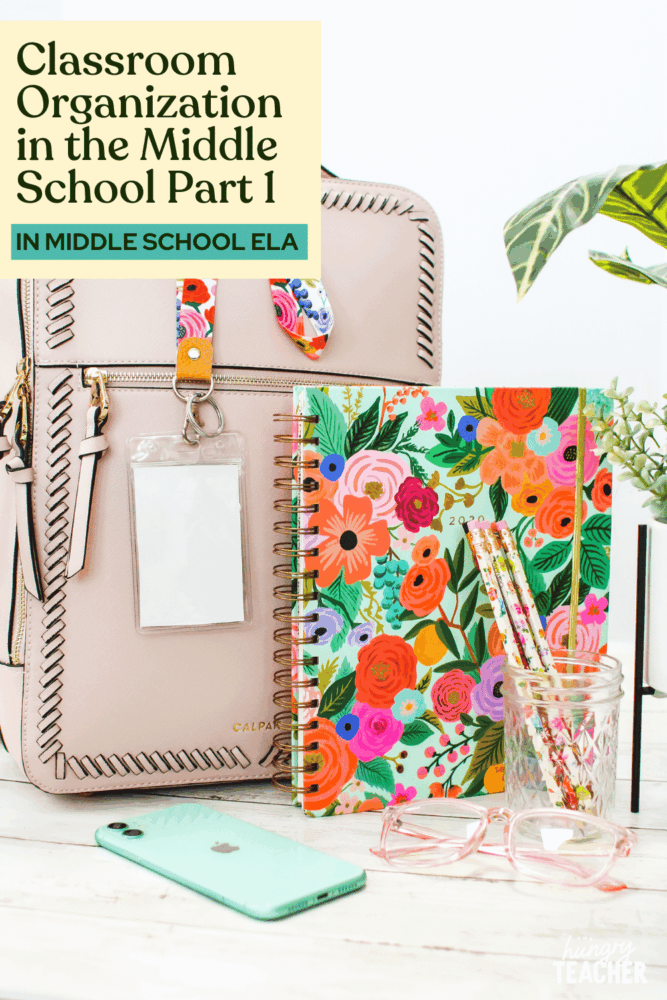
Get the Organization Overhaul Complete Classroom Course
organization during student teaching
My first year, I now had to do it every single week, and like many teachers’ first year, it was just hard to stay organized, prepped, and ready all the time (really most of the time).
Again, I hadn’t realized all the background work Kelly had been doing (it’s pretty much a miracle, because I talked her head off for an entire school year).
Like most new teachers, I was just trying to keep my head above water. Sometimes, I had a rough idea of the day, but would get to the lesson, and be kind of lost (keeping it real). I also would make copies and/or prep for lessons and make piles for what I needed, but then have a hot mess at the end of the day, and forget what I had even done.
In “real life,” I was really good at organization, but I was honestly really struggling with teaching.
I’d like to say that come October, I started to get in a groove… ha! It wasn’t until about March or April, when I had finally survived testing, and could relax a little, that I decided that maybe I should use my plan time for actual planning (I’m a fast learner ha!) and try to get a little organized.
My horseshoe table was also almost completely covered at the end of each day, and I kind of wanted to teach some small groups. Again… first year teacher over here… just keeping my head above water.
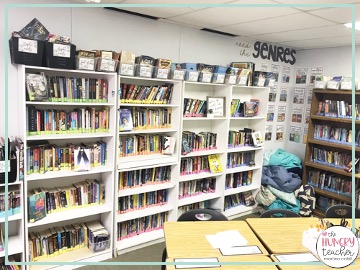
FIRST YEAR ORGANIZATION
During my student teaching experience, I had the best mentor teacher ever. Kelly had moved so smoothly from subject to subject and she was at a point where she could do a rough plan of her lessons and teach from there.
You know how it is… I learned A TON that year of student teaching, especially from watching and learning from Kelly… and thought I knew what I was doing going into my first year, but really… I had no idea.
For me, my first year is kind of a blur in many ways, but I do remember that it was a good day if I had more than two days worth of lessons planned and prepped ahead of time. A really good day was if I could see the top of my teacher desk… at least a part of it.
The year before, Kelly really pushed me to plan a week at a time. I mostly started to get better at it, but in fairness, I only had to take over the class for about 3-4 weeks. It was exhausting at the time, but in hindsight that seems so simple now.
Planning a week at a time
I finally started to plan ahead a week at at time, instead of a couple of days. Now this was great, but it also created a whole new set of logistics and organization that I wasn’t ready for:
- What do I do with next week’s copies?
- Where do I keep the copies organized by subject?
- Do I know that I did all the stuff I need to do every week?
- How do I know that I actually have all the supplies (i.e. science), when I’m not thinking about it the night before. Stuff like this was really hard for me. I was good at going to the store the night before a lesson, because that’s usually when I was prepping or planning for the lessons, but once I started planning a week ahead I realized I couldn’t remember what I had actually done. I didn’t want to plan for next Thursday, get to that science lab, and realize that I forgot all the supplies I needed.
- How can I remember everything I did or need to do?!
I got super organized because of all of these questions I had. My second year in fifth grade was SO much better, so much more organized, and so much more thought out but….
organization in different classrooms
Since then I’ve switched grades and schools three times (in four years no less), and have had to adjust EVERY SINGLE TIME. This means I really have to stay on top of my systems so I don’t lose my mind each time.
Here I explain how my systems have worked in each of the teaching settings I have been in and they have evolved each time:
- 5th grade self-contained for two years
- 6th grade ELA/STEM and 5th grade STEM for one year
- 7th/8th grade ELA and 6th grade books and movies currently (going on year four now ).
All of these settings have really pushed me as a teacher, but also on an organizational level. I hope you all can learn something new from my
Mistakes…and successes!
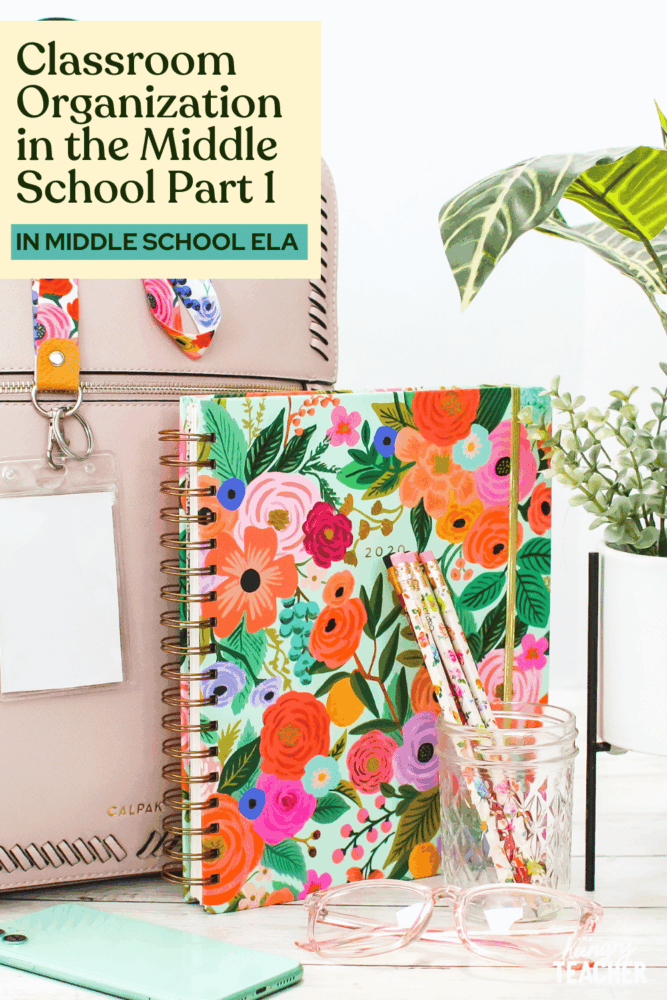
LESSON PLAN MATERIAL ORGANIZATION
This is the single one system that changed my life at the end of my first year of teaching. I have five bins (one bin for each day of the week) and then folders for each subject.
When I taught 5th Grade self contained, my folders were like this:
- Pink: Math
- Yellow: Language/Spelling/Vocabulary/Grammar
- Green: Reading
- Purple: Writing
- Blue: Science or Social Studies
I haven’t even taught this in about two years, but I can remember the exact order and colors I taught them because of this system. The order above is the order I would teach each subject each day.
Copies for each subject and put them in the folder and the correct day. Then on Monday, I would just grab the purple folder during math, the blue during language, etc.
It was my first and second years so I don’t have a picture because who am I kidding? Ha! But here is a diagram. You can see a picture of the bins and folders in a couple of pages (in my current classroom).

ORGANIZATION OF 6TH GRADE FOLDERS
When I moved to 6th grade last year, it was honestly harder than my first year of teaching in a lot of ways. Mostly, my husband and I moved unexpectedly (we were living in a hotel when I started school), I accepted what I thought was self-contained, but turned out to be only ELA and STEM (kind of), and A LOT of stuff was thrown at me all year.
I obviously didn’t have time to plan or prep over the summer (actually I had done an amazing job of planning and prepping for fifth grade, but then we moved ha!). The organization and keeping track of everything was a struggle because I wasn’t used to, or even planning on switching throughout the day. I tried to use these previous systems but found that they needed to be “adapted” to my new surroundings.
Initially I thought I would have a folder for each subject for each class. Meaning, I would have blue for 6A reading and a green folder for 6B reading, then yellow for 6A writing and then orange for 6B writing. THIS DID NOT WORK and was really kind of dumb on my part! Ha! I was doing the same thing (most of the time) in both of my 6th grade ELA classes, so it was honestly too confusing. Eventually I just had this set up:
- Pink: 6th Grade Writing
- Yellow: 6th Grade Reading
- Green: 6th Grade Grammar and Vocabulary
- Purple: 6th Grade Science
- Blue: 5th Grade Science

MIDDLE SCHOOL ORGANIZATION
Doing it by class hour was just silly, because like I said, I do the same things with each grade level. It’s so annoying to make 50 copies and then have to put ½ in first period for 7th grade and ½ in second period for 7th grade. I just put all 7th grade copies in one folder.

This is the order I see my classes and their coordinating colors. There is also a yellow folder in each bin, for stuff #Icanteven deal with right now, but may need for all classes at some point throughout the day (Scholastic orders, notes home, etc.)

I am all about stuff not being annoying. I DO NOT stick the stacks in the folder pocket. This makes it so I don’t even have to pull the folder out of the bin. I just stick the stacks in the folder. I tend to paperclip the stack so I can easily grab the whole thing when it’s time for the lesson.

If you’re wondering what I tend to have in these folders, it’s almost always copies for interactive notebooks.
In middle school, this mostly consists of Lovin’ Lit’s interactive notebook pages. This is also where I put our practice sheets and tests whenever I have them.

Extra MATERIALs ORGANIZATION
This is one of those organizational systems that came to be on accident.
At my previous school, we had crazy copy limits, but we could send stuff to a print shop. In theory it was meant to save money, but I found myself making an entire year’s or quarter’s worth of copies because it put me in a panic thinking about not being able to make copies as I needed them.
Honestly, most teachers did this, but many did it because they knew the copy budget would run out eventually.
Anyway, it created stacks of copies that I needed to organize so I could find them when I actually needed them.
For example, these pages, were my grammar interactive notebook pages. They were grouped in sets, when they would come from print shop. So basically I would ask for 50 copies of 40 different pages.
They came grouped in sets, but that meant I would have have to dig through the delivery box and make sure I just had that stack of 50 I needed for that weeks’ lessons.
This is also meant that if I skipped around, I would then have to dig through the box to find the right stacks.
Long term extra materials
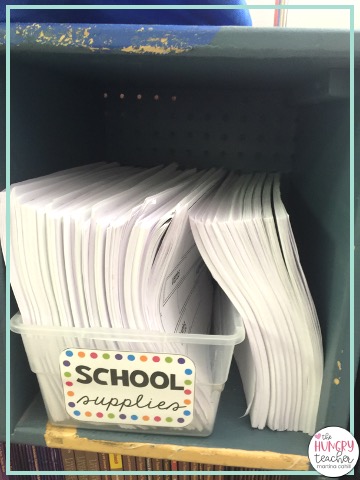
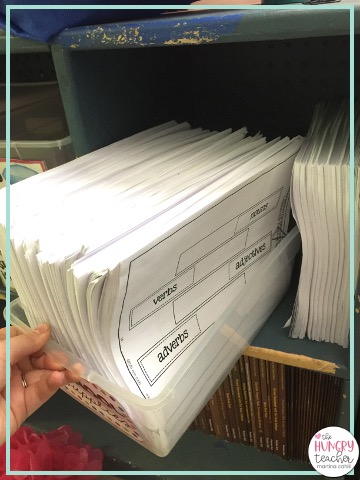
I knew I needed the copies to be in a visible container, and already separated into stacks that I could grab as I needed them.
During my plan hour one week, I actually took all the copies out of the old box. Then I separated them into stacks with paper clips. Those stacks went into these clear bins and I put them all facing in the same direction. Now I could easily sift through the stacks to find what I needed, simply based on the front page.
The nice thing was that these clear plastic bins took up way less room than my box from print shop. Plus they could still be tucked away on my shelves.
Full disclosure: these are all the copies I had leftover from last year (because my panic induced copying had me make the copies for the year, and we didn’t get to all of them in both of my classes).
It actually worked out for once though, because I can use these copies with my 7th grade class this year. I know I have 50 copies of each, and they are already separated for me!
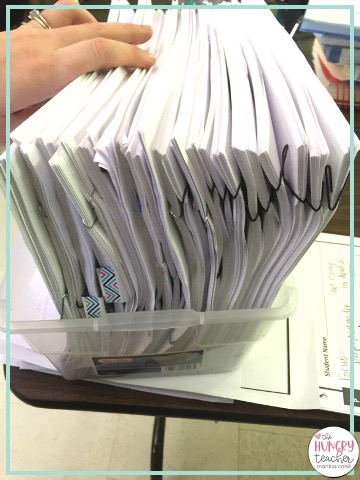
Over the years, especially after being in the same classroom for three years, I honestly have just wanted things out of my face. I want things to look pretty and intentional.
Those paper clipped sets have just gotten an upgrade into file folders organized by CCSS standards. Then I used some old pretty colorful folder I had and organized by content category. These are the leftover copies I have.


Miscellaneous Organization
I have recently learned about having a place for every piece of paper, in the history of infinity. This was my solution.
Then I bought one of these 10 drawer organizers. I mapped out the types of papers I tend to pile on my desk, because I can’t throw them away *yet, but I also don’t know what to do with them until then.
- The Box: When kids come in and hand me stuff, but #Icanteven at the time, it just goes in the box.
- Office: Stuff that needs to go to the office.
- File: Stuff I need to file. This is for stuff that goes into my binders or in a permission slip type location.
- Do it: Stuff I need to do soon, but don’t want it out on my desk.
- Keep: Stuff I need to hold on to, but won’t need to keep forever. Permission slips, agendas, or rosters until the field trip day.
- Grade: Need to grade; mostly essays L
- Work: Stuff I’m in the middle of working on, but don’t want to put away (i.e. cutting or lamination).
- Copy: Usually the originals of stuff I need to copy for next weeks’ lessons before I put them in the daily bins.
- Copies: Extra copies. I put absent students work in their class hour folder (more on that later) but extras go in here and kids can dig through it and hope for the best if they mess up or if they lose something.
- Scholastic Book Orders: This is where extra book orders go. I use a binder and organizational system for orders, from Literacy for Big Kids.
- Misc.: basically another junk drawer J.

WEEKLY PLANNING ORGANIZATION
This is “The Binder.” This thing literally goes with me everywhere, and by everywhere I mean, it’s always in my teacher bag at home or at school with me. If nothing else, I ALWAYS have my flash drive and this binder.
I have five sections in this binder. It basically made it so I can work on all my important stuff, and not forget anything whether I’m at home, at school, or even at a Starbucks.
- The cover has my long term-pages right up front, so I don’t forget due dates.
- One: The first has my daily checklist (examples on next pages).
- Two: The second section has my weekly checklist for the stuff I need to do every single week (examples on next pages).
- Three: The third section is just where I keep notes for resources I’m working on, blog posts, etc. for TeachersPayTeachers and my blog.
- Four: The fourth section is for my current semesters of grad school. I print my syllabus, and assignments, and work on them whenever I can.
- Five: The final section typically holds my pacing guides, standards, or anything else I tend to reference regularly enough that it has been deemed special enough to make its way to the “The Binder.”
my teacher checklists

This is my weekly checklist. It changes every year based on the stuff I that I need to do EVERY SINGLE WEEK. I go overboard with the list, but if I don’t need to do it some weeks then I just cross it out (and then I feel better about myself).
You can get this as an editable freebie by clicking here.
This is my “daily checklist” system. I got the idea from a variety of places, but essentially a life planner I had, some blog posts, and other teachers made me realize that I need to break my day into chunks, so I don’t have pages and pages of to-do lists and then forget to do the important stuff. It’s a two page spread and I just print one each week to keep track of what I need to accomplish each day.
All my checklists are available in my growing bundle of teacher checklists.
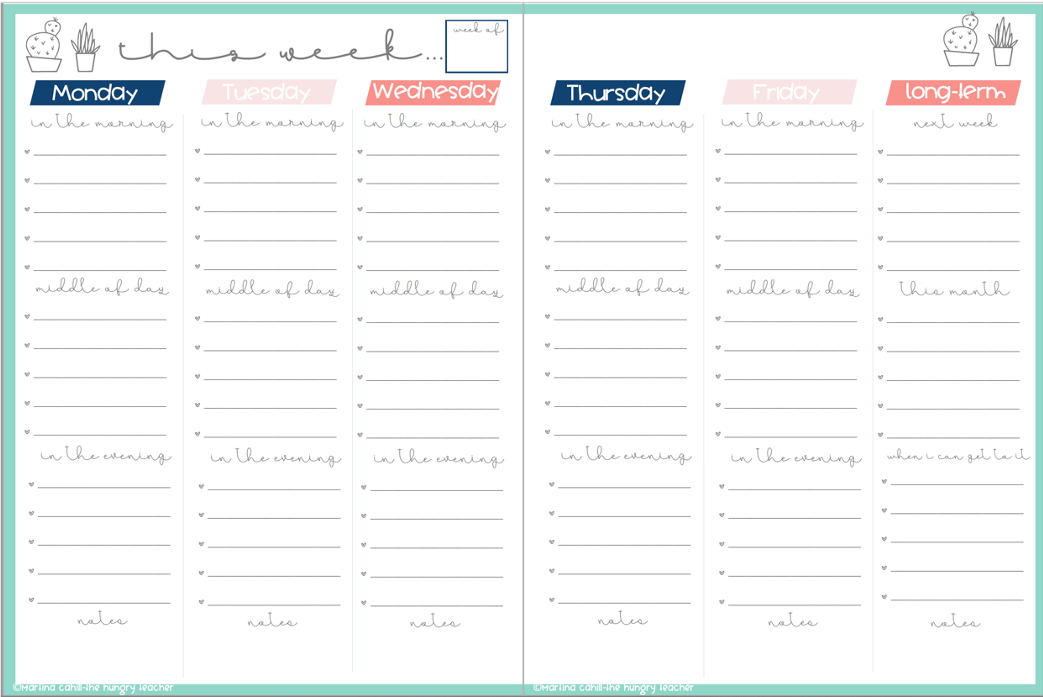
This middle school English teacher grading strategies for upper elementary and middle school grading and assessment blog post is part of a classroom organization series. This is part one of eight blog posts all about how I organize different areas of my classroom. Click on any of the links to be taken to each of the posts in the series:
- One: Lesson Planning and Lesson Materials Organization
- Two: Teacher Materials Organization
- Three: Student Materials Organization
- Four: Classroom Routines and Novels Organization
- Five: Classroom Library Organization
- Six: Book Clubs, Novel Sets, and Literature Circles
- Seven: Small Group Organization
- Eight: Grading and Assessment
CLICK HERE to get the Organization Overhaul Complete Classroom Course plus bonus resources for each module.
CLICK HERE to get the complete printable organization E-Book.

Get the Organization Overhaul Complete Classroom Course
Want a sneak peek at teaching The Hungry Teacher way—with support, structure, and strategy?
When you join the waitlist for The Hungry Teacher’s Hub membership, you get three free classroom-ready resources: a theme unit, an expository writing unit, and a grammar unit introducing mentor sentences. Plus, you’ll get immediate access to a selection of exclusives from the Hub, including editable sub plans, pacing guides, and more.
No strings attached. Just resources you can use right now—and a heads-up when the Hub opens.
3 Free Middle School ELA Units—yours to keep!
JOIN THE WAITLIST + A FREE GIFT
Where to next, line leader?
Welcome to The Hungry Teacher! We create resources that are easy to use, practical, and get results. Teach with confidence—and make it home before dinner.
xo, the hungry teacher
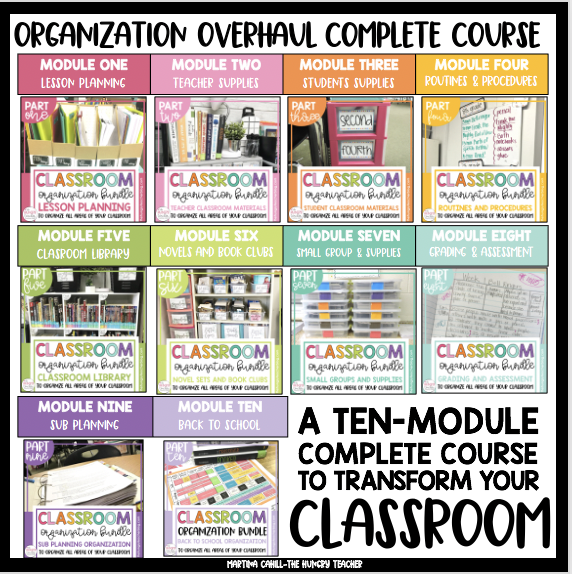
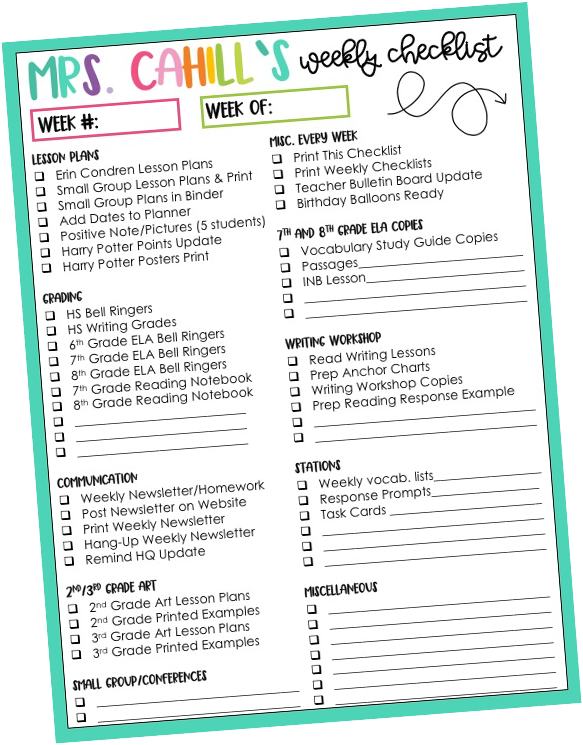
MARTINA!!!! You are a LIFESAVER! I am a "first year" teacher of middle school STEM (6th, 7th and 8th grade). I started in the middle of the school year last year and this will be my first full year teaching STEM to all three grades.
I too am a fairly organized person in my personal life but I fall short in regards to my teaching life. Your tips have inspired me to get my act together because Lord knows I need the help. School starts in just 2 weeks!!!! I want to have myself planned out weeks at a time but I don't want to forget what I planned with out it being right in front of me the night before.
Thank you for your posts, I haven't even finished reading all of them but I am already so grateful to you for your blog!!! If you have any other information specifically related to STEM I would be soon appreciative.
Sincerely,
Michelle
Surviving Teacher
Thank you so much for sharing this! I'm a second year high school teacher and have 6 classes from year 7-12. I'm not a naturally neat and organised person but I want to be. I am trying to tackle my desk mess this week and find a system that stops it and makes me feel more organised. I will definitely be giving your resource system a spin to see if it works better for me than binders do (I tend to get annoyed with plastic sleeves and just stop using that or any system… ). I'm off to read your other posts now ��